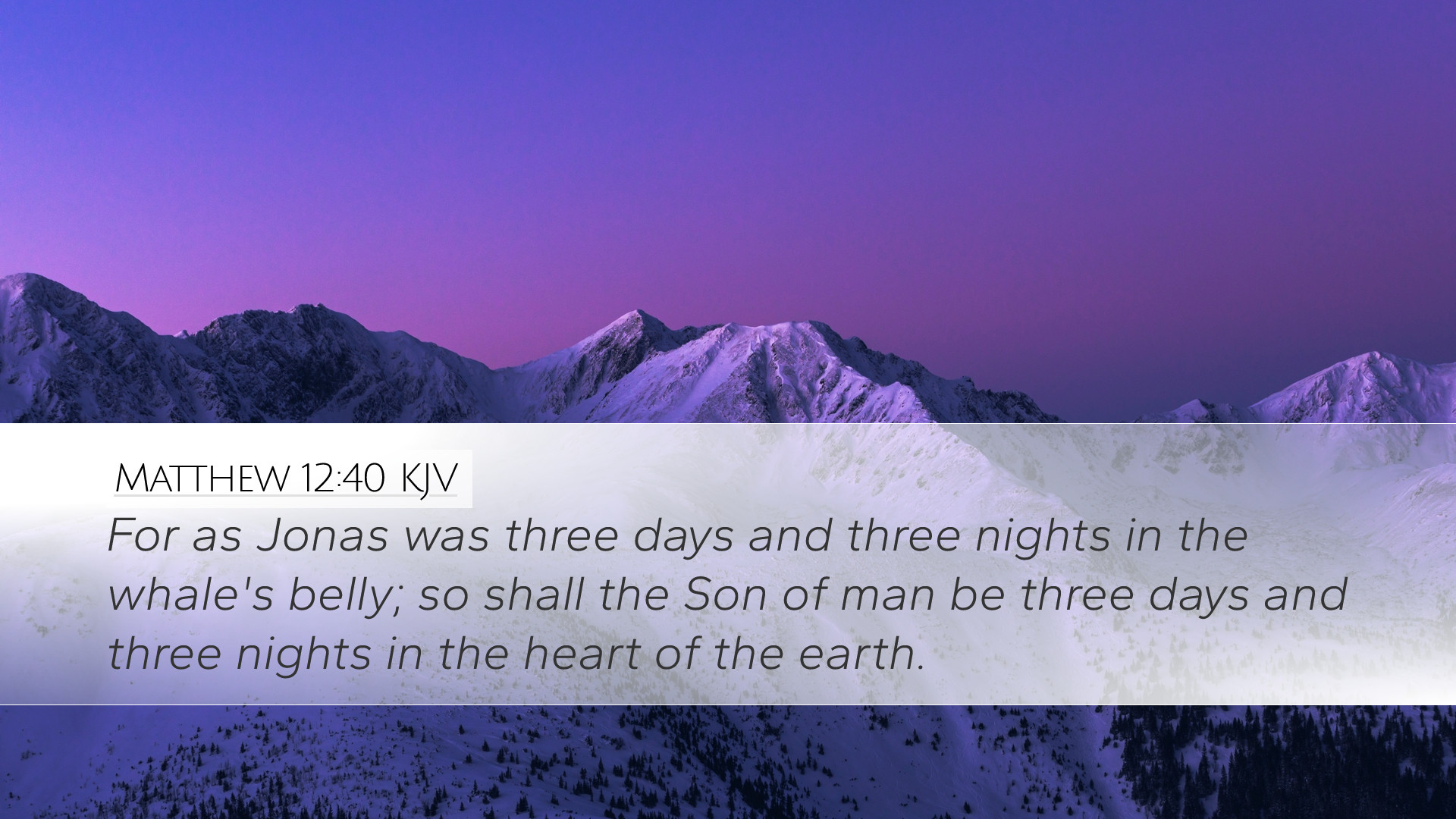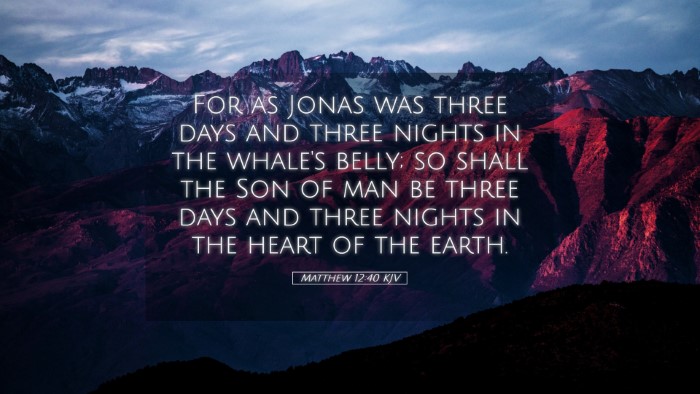Commentary on Matthew 12:40
Verse: "For as Jonah was three days and three nights in the whale's belly; so shall the Son of man be three days and three nights in the heart of the earth."
Introduction
The comparison that Jesus makes between Jonah's experience and His own impending death and resurrection is rich in theological significance. This verse serves as a crucial point of reflection for pastors, theologians, and students of the Bible, as it links the Old Testament narrative of Jonah to the New Testament revelation of Christ's work of redemption. In this commentary, we explore insights from respected public domain sources to unpack the depth of this verse.
Historical Context
Matthew wrote his Gospel primarily to a Jewish audience, emphasizing the fulfillment of Old Testament prophecies in the life and ministry of Jesus. The reference to Jonah is pivotal for illustrating this connection. Jonah's reluctant mission to Nineveh and his experience in the belly of the great fish prefigure Christ's own journey into death and subsequent resurrection, thus affirming the continuity of God's redemptive plan throughout scripture.
Jonah's Experience
According to Matthew Henry, Jonah’s entrapment in the whale illustrates the depths of God’s grace and mercy. Just as Jonah was saved from utter darkness, Jesus indicates that His resurrection will show divine triumph over death. Henry emphasizes the miraculous nature of both occurrences as signs of God’s sovereign power to deliver.
Adam Clarke expands upon this by discussing the significance of "three days and three nights." He draws attention to the Jewish understanding of time, affirming that the phrase suggests a complete and sufficient duration, symbolizing the fulness of Christ's sacrifice. This would resonate deeply with Jesus’ Jewish listeners, reinforcing the historical authenticity of both the Jonah narrative and the ultimate resurrection.
Theological Implications
This verse encapsulates a fundamental tenet of Christian theology: the resurrection of Jesus Christ as a pivotal event in salvation history. Albert Barnes notes that the resurrection not only confirms Jesus' identity as the Messiah but also acts as a definitive proof of the victory over death. Therefore, as Jonah represents the plight of disobedience, Christ represents the fulfillment of obedience unto death, highlighting the stark contrast in the narratives.
- Symbolism of Death and Resurrection: The whale serves as a metaphor for the grave, emphasizing the period of Jesus' death and the transformative power of His resurrection.
- Significance of Prophecy: This parallel serves as a prophetic sign, as Jesus frequently invoked Jonah’s story to authenticate His ministry and validate His message to the Jews.
- Obedience and Repentance: Just as Jonah’s three days led to repentance among the Ninevites, so too does Jesus’ resurrection offer the opportunity for redemption to all humanity.
Practical Applications
This verse invites reflection on the nature of faith and obedience. For pastors, it emphasizes the call to acknowledge and respond to God's sovereign authority over life and death. Matthew Henry suggests that just as Jonah was called to a mission he initially rejected, modern believers are urged to embrace their own divine callings, even amidst uncertainty or fear.
Albert Barnes provides further practical implications by encouraging believers to be vigilant in their spiritual walk, drawing parallels between the unrepentant generation of Jesus’ time and contemporary society. The invitation to recognize signs and heed God’s messages serves as a cornerstone for faithful living today.
- Affirmation of Faith: The resurrection assures believers of a future hope beyond death.
- Call to Action: Followers are challenged to proclaim the gospel boldly, much like Jonah was ultimately compelled to do.
- Encouragement in Trials: Reflecting on Jesus’ death and resurrection can bring comfort during personal trials, reminding the faithful of eventual victory.
Conclusion
Matthew 12:40 serves both as a bridge between the Old and New Testaments and as a profound statement about Jesus’ mission. The insights from Matthew Henry, Albert Barnes, and Adam Clarke collectively underscore the significance of understanding Jesus as the fulfillment of the prophetic scriptures. This verse challenges not only our understanding of time and the nature of signs but also calls us to a deeper faith and obedience in the face of our circumstances.
In summary, Jesus draws a parallel to Jonah’s experience to affirm His own death and resurrection as God's ultimate expression of mercy and grace, thereby inviting believers to enter into the fullness of life that comes through faith in Him.


